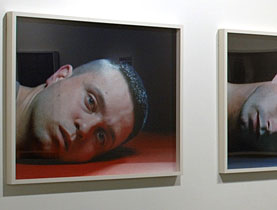Camera focuses on hidden traces of suffering

There are no desert fatigues or gun to identify this US soldier on leave from Iraq, just his face and piercing blue eyes that communicate the suffering he witnessed.
The unsettling portrait of the young GI Bruno is part of a new photo exhibition, Stigmata, held at Geneva’s International Red Cross Museum, that aims to show the traces left behind on people and landscapes after a “disaster”.
The exhibition, organised by Lausanne’s Musée d’Elysée photo museum, brings together seven contemporary photographers from around the world to present different legacies of suffering.
These include themes such as the psychological effects of the Iraq war or sexual trafficking from Moldova, the impact of natural disasters, like Hurricane Katrina on New Orleans, or of human massacres in the seemingly peaceful Bosnia-Herzegovina countryside.
Stigmata makes the visitor reflect upon the way in which the traces of human suffering and the vestiges of a natural disaster can permeate people and places.
“Through this exhibition we tried to highlight the fact that humanitarian action is not necessarily finished after emergency aid. Often interventions are more long term, until the victims have recovered their dignity and a normal existence,” Sandra Sunier, the Red Cross Museum’s curator, told swissinfo.
The unforgettable
New York photographer Suzanne Opton’s unusual raw images of GIs just back from Iraq are particularly striking. By lying on their sides on a table the young soldiers seem to expose their fragility and humanity.
“By taking these portraits I simply wanted to observe the faces of people who have seen the unforgettable,” said Opton.
This photo is an excellent example of how the eyes are the windows to the soul, explained Klaus Scherer, director of the Swiss Centre for Affective Sciences based at Geneva University, pointing to the photo of Bruno who spent 35 days in Iraq.
“There is this completely hopeless, resigned look in his face,” he told swissinfo. “The muscles in his face and mouth are very tense and you have the impression that he is reliving something horrible.”
Scherer, who heads the world’s only research centre dedicated to the interdisciplinary study of emotions and their effects on human behaviour and society, is particularly impressed by the exhibition.
“The meaning of each photo is not revealed immediately – you need time to enter each one,” he noted. “It means you contribute a lot more of your own emotional memory which resonates with what you see.”
Restoring humanity
Just down the corridor Pieter Hugo’s frank portraits, entitled “Albinos”, confront us with people who are inherently “different”. Even today, and especially in Africa, albinos are looked upon as bearers of ill fortune or individuals with magic powers. Subjected to physical attack and even amputation, albinos in certain parts of Africa lead hunted lives.
Hugo’s photos set out to change the perception of albinos. His close-ups force the viewer to modify their way of looking, and in so doing, restores to the subjects the humanity that has been denied them.
“Belonging to a group is so extremely important to humans, so being excluded is an indescribable emotion,” said Scherer.
Elsewhere, Christian Schwager’s Bosnian landscapes look like havens of peace. Yet his series of countryside images evoke dreadful events – three mass graves were found there in 2004.
In a world bombarded by graphic images of atrocities, Schwager’s reflective approach can appear just as powerful as that of a traditional war photographer. As we move from one beautiful pastoral scene to the next, our suspicion over the upturned earth grows, slowly driving out the natural beauty.
Emotional impact
Gustavo Germano offers images of the indirect victims of the Argentinean military dictatorship’s liquidation plan of 1976-1983, which led to the disappearance of 30,000 people.
Using photo albums dating back 30 years, Germano took new photos of victims’ families in similar positions and settings, leaving an empty space previously occupied by the missing family member. The emotional force of the simple family portraits side by side, and the underlying message, is startling.
A photo has a much greater emotional impact than say a film, said Scherer.
“When we watch a news programme our attention is taken up by trying to understand the developments, while a fixed image is constantly being refreshed by our emotional memory,” he said.
The exhibition shows how photos still have a unique, subtle resonating power, added the exhibition’s curator, Nathalie Herschdorfer.
“In the era of television, the internet and many other new media, the works of these photographers show that a fixed image still really manages to provoke emotions and thoughts about the reality that surrounds us,” she told swissinfo.
swissinfo, Simon Bradley in Geneva
The International Red Cross and Red Crescent Museum relates the story of the Red Cross and Red Crescent Movement. Its mission is to preserve the Red Cross heritage and to promote a certain idea of human solidarity by depicting the work of the world’s first humanitarian organization.
An original display of photographs, films, writings and unusual objects provides a fresh look at the evolution of interventions in case of conflicts and natural disasters.
The museum also regularly holds temporary exhibitions like Stigmata, which runs until July 26.
Lausanne’s Musée d’Elysée is one of the first museums in Europe to devote itself exclusively to photography.
The National Research Centre for the Affective Sciences is the first national research centre in the world dedicated to the interdisciplinary study of emotions and their effects on human behaviour and society. The centre is financed by the Swiss government and overseen by the Swiss National Science Foundation.

In compliance with the JTI standards
More: SWI swissinfo.ch certified by the Journalism Trust Initiative












You can find an overview of ongoing debates with our journalists here . Please join us!
If you want to start a conversation about a topic raised in this article or want to report factual errors, email us at english@swissinfo.ch.